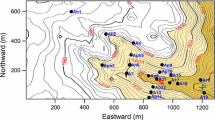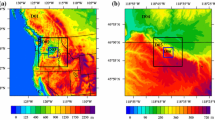Abstract
We have analyzed measurements of vertical velocity w statistics with the NOAA high resolution Doppler lidar (HRDL) from about 390 m above the surface to the top of the convective boundary layer (CBL) over a relatively flat and uniform agricultural surface during the Lidars-in-Flat-Terrain (LIFT) experiment in 1996. The temporal resolution of the zenith-pointing lidar was about 1 s, and the range-gate resolution about 30 m. Vertical cross-sections of w were used to calculate second- to fourth-moment statistics of w as a function of height throughout most of the CBL. We compare the results with large-eddy simulations (LES) of the CBL and with in situ aircraft measurements. A major cause of the observed case-to-case variability in the vertical profiles of the higher moments is differences in stability. For example, for the most convective cases, the skewness from both LES and observations changes more with height than for cases with more shear, with the observations changing more with stability than the LES. We also found a decrease in skewness, particularly in the upper part of the CBL, with an increase in LES grid resolution.
Similar content being viewed by others
References
Angevine WM, Grimsdell AW, Hartten LM, Delany AC (1998) The flatland boundary layer experiments. Bull Amer Meteorol Soc 79: 419–431
Ansmann A, Fruntke J, Engelmann R (2010) Updraft and downdraft characterization with Doppler lidar: cloud-free versus cumuli-topped mixed layer. Atmos Chem Phys 10: 7845–7858
Canut G, Lothon M, Said F (2010) Observation of entrainment at the interface between monsoon flow and saharan air layer. Q J R Meteorol Soc 136(s1): 34–46
Cohn SA, Mayor SD, Grund TM, Weckwerth TM, Senff C (1998) The lidars in flat terrain experiment (LIFT). Bull Am Meteorol Soc 79: 1329–1343
Grund CJ, Banta RM, George J, Howell JN, Post MJ, Richter RA (1998) High-resolution Doppler lidar for boundary layer and cloud research. J Atmos Ocean Technol 18: 376–393
Gryanik VM, Hartmann J (2002) A turbulence closure for the convective boundary layer based on a two-scale mass-flux approach. J Atmos Sci 59: 2729–2744
Gryanik VM, Hartmann J, Raasch S, Schröter M (2005) A refinement of the millionshchikov quasi-normality hypothesis for convective boundary layer turbulence. J Atmos Sci 62: 2632–2638
Hicks B, Wesely M (1981) Heat and momentum transfer characteristics of adjacent fields of soybeans and maize. Boundary-Layer Meteorol 20: 175–185
Hunt JCR, Kaimal JC, Gaynor JE (1988) Eddy structure in the convective boundary layer—new measurements and new concepts. Q J R Meteorol Soc 482: 827–858
Kaimal JC, Wyngaard JC, Haugen DA, Coté OR, Izumi Y (1976) Turbulence structure in the convective boundary layer. J Atmos Sci 33: 2152–2169
Lenschow DH, Stephens PL (1982) The role of thermals in the convective boundary layer. Atmos Environ 16: 761–764
Lenschow DH, Wyngaard JC, Pennell WT (1980) Mean-field and second-moment budgets in a baroclinic, convective boundary layer. J Atmos Sci 37: 1313–1326
Lenschow DH, Mann J, Kristensen L (1994) How long is long enough when measuring fluxes and other turbulence statistics?. J Atmos Ocean Technol 11: 661–673
Lenschow DH, Wulfmeyer V, Senff C (2000) Measuring second- through fourth-order moments in noisy data. J Atmos Ocean Technol 17: 1330–1347
Lothon M, Lenschow DH, Mayor SD (2006) Coherence and scale of vertical velocity in the convective boundary layer from a Doppler lidar. Boundary-Layer Meteorol 121: 521–536
Lothon M, Lenschow DH, Mayor SD (2009) Doppler lidar measurements of vertical velocity spectra in the convective boundary-layer. Boundary-Layer Meteorol 132: 205–226
Militzer JM, Michaelis MC, Semmer SR, Norris KS, Horst TW, Oncley SP, Delany AC, Brock FV (1995) Development of the prototype pamiii/flux-pam surface meteorological station. In: Proceedings of the 9th symposium on meteorological observations and instrumentation. American Meteorological Society, Boston, pp 490–494
Moeng CH (1984) A large-eddy simulation model for the study of planetary boundary-layer turbulence. J Atmos Sci 41: 2052–2062
Moeng CH, Rotunno R (1990) Vertical velocity skewness in the buoyancy-driven boundary layer. J Atmos Sci 47: 1149–1162
Moeng CH, Wyngaard JC (1988) Spectral analysis of large-eddy simulations of the convective boundary layer. J Atmos Sci 45: 3573–3587
O’Connor EJ, Illingworth AJ, Brooks IM, Westbrook CD, Hogan RJ, Davies F, Brooks BJ (2010) A method for estimating the turbulent kinetic energy dissipation rate from a vertically pointing Doppler lidar, and independent evaluation from balloon-borne in situ measurements. J Atmos Ocean Technol 27: 1652–1664
Redelsperger JL, Thorncroft C, Diedhiou A, Lebel T, Parker DJ, Polcher J (2006) African Monsoon Multidisciplinary Analysis (AMMA): an international research project and field campaign. Bull Am Meteorol Soc 87: 1739–1746
Sullivan PP, Patton EG (2011) The effect of mesh resolution on convective boundary-layer statistics and structures generated by large-eddy simulation. J Atmos Sci (in press)
Sullivan PP, McWilliams JC, Moeng CH (1994) A subgrid-scale model for large-eddy simulation of planetary boundary layer flows. Boundary-Layer Meteorol 71: 247–276
Sullivan PP, McWilliams JC, Moeng CH (1996) A grid nesting method for large-eddy simulation of planetary boundary-layer flows. Boundary-Layer Meteorol 80: 167–202
Tennekes H (1973) A model for the dynamics of the inversion above a convective boundary layer. J Atmos Sci 30: 558–567
Weckwerth T (1999) An observational study of the evolution of horizontal convective rolls. Mon Weather Rev 127: 2160–2179
Weil JC, Corio LA, Brower RP (1997) A PDF dispersion model for buoyant plumes in the convective boundary layer. J Appl Meteorol 36: 982–1003
Wyngaard J (1988) Structure of the PBL. In: Venkatram A, Wyngaard J (eds) Lectures on air pollution modeling. American Meteorological Society, Boston
Wyngaard JC, Cote O (1971) The budgets of turbulent kinetic energy and temperature variance in the atmospheric surface layer. J Atmos Sci 28: 190–201
Wyngaard JC, Cote O, Izumi Y (1971) Local free convection, similarity, and the budgets of shear stress and heat flux. J Atmos Sci 41: 1171–1182
Author information
Authors and Affiliations
Corresponding author
Rights and permissions
About this article
Cite this article
Lenschow, D.H., Lothon, M., Mayor, S.D. et al. A Comparison of Higher-Order Vertical Velocity Moments in the Convective Boundary Layer from Lidar with In Situ Measurements and Large-Eddy Simulation. Boundary-Layer Meteorol 143, 107–123 (2012). https://doi.org/10.1007/s10546-011-9615-3
Received:
Accepted:
Published:
Issue Date:
DOI: https://doi.org/10.1007/s10546-011-9615-3




